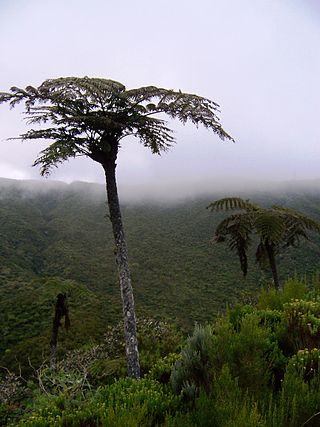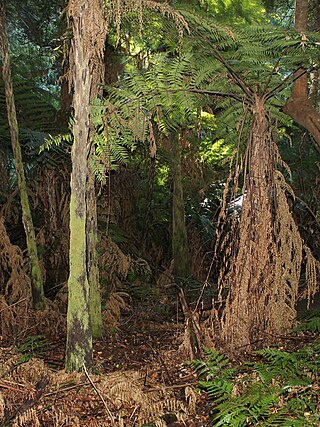
Sphaeropteris cooperi, synonym Cyathea cooperi, also known as lacy tree fern, scaly tree fern, or Cooper's tree fern, is a tree fern native to Australia, in New South Wales and Queensland.

Cyathea is a genus of tree ferns, the type genus of the fern order Cyatheales.

Sphaeropteris is a genus of tree ferns in the family Cyatheaceae. It has been treated as a subgenus within the genus Cyathea, but is accepted in the Pteridophyte Phylogeny Group classification of 2016.
Gymnosphaera biformis, synonyms Alsophila biformis and Cyathea biformis, is a species of tree fern native to New Guinea and the Maluku Islands, where it grows against trees in mossy forest and rain forest at elevations of 850–2200 m. The climbing trunk is very thin, only 1–2 cm in diameter, but can reach 3 m in height. The apex of the trunk is covered in scales. Two types of fronds are produced, simple pinnate fronds, which are sterile, and bipinnate fronds, which may be fertile. The stipe is smooth, glossy and very dark, almost to the point of being black. It is covered at the base with long, very dark scales that have a pale margin. Fertile pinnules are distinctly stalked and lobed. Sori occur in four pairs per pinnule lobe and lack indusia.
Alsophila buennemeijeri, synonym Cyathea buennemeijeri, is a species of tree fern endemic to the Natuna Islands in Indonesia. In the World Geographical Scheme for Recording Plant Distributions, these islands are treated as part of Kalimantan. A. buennemeijeri grows in open scrub at an altitude of about 600 m. This rare species is known only from the summits of two low hills. The trunk is erect and may be 5 m tall or more. Fronds are bi- or tripinnate and 2–3 m long. The stipe is dark and covered with spines at the base, as well as numerous scattered dark scales with pale, fragile edges. Sori occur near the midvein of fertile pinnules and are covered by thin, fragile indusia that resemble cups in shape.
Alsophila camerooniana, synonym Cyathea camerooniana, is a species of tree fern native to Sierra Leone, Cameroon, northern Angola and western Uganda, where it grows in montane forest at an altitude of 900–1200 m. The trunk is erect and 2–3 m tall. Fronds are pinnate and 2–3 m long. The rachis ranges in colour from dark to pale and has some hairs on the underside. The stipe is dark and is covered with scales throughout. Where scales have fallen, small warts are present. The scales are glossy brown and have a thin, dull edge. Sori occur at the forks of veins and are covered by thin indusia, which range in shape from cup- to saucer-like.
Alsophila hermannii, synonym Cyathea christiiCopel., is a species of tree fern endemic to Mindanao in the Philippines, where it grows in forest at an altitude of 900–1800 m. The trunk is erect and may be 5 m tall or more. Fronds are bi- or tripinnate and 2–3 m long. The stipe is covered with some warts and narrow, brown scales. Sori occur near the midvein of fertile pinnules and are covered by thin, fragile indusia.
Alsophila costalisora, synonym Cyathea costalisora, is a species of tree fern native to western New Guinea, where it grows on the edges of forest and in moist hollows at an altitude of 1900–3225 m. The trunk is erect, up to 4 m tall and may branch near the base. Fronds are bi- or tripinnate and 1–1.5 m long. The stipe is warty, especially where scales have fallen. The scales are pale and have a distinctive dark glossy central region, with a paler dull margin. Sori are round and occur near the fertile pinnule midvein. They are covered by firm, dark indusia that are cup-like in appearance.
Alsophila jimeneziana, synonym Cyathea crassa, is a species of tree fern endemic to the Dominican Republic. Little is known about this rare tree fern.

Alsophila dregei, synonym Cyathea dregei, is a widespread species of tree fern in southern Africa.
Alsophila engelii, synonym Cyathea elongata, is a species of tree fern native to Venezuela and Colombia, where it grows in montane areas at an altitude of 2000–3000 m. The trunk is erect and up to 11 m tall. Fronds are pinnate and usually 2–3 m long. The rachis and stipe are brown, may be smooth to warty and have basal tan scales. Sori occur in small groups towards the base of the pinnule midvein and are covered by cup-like indusia.
Alsophila imrayana, synonym Cyathea imrayana, is a species of tree fern native to Dominica, Costa Rica, Panama, Venezuela, and Ecuador.
Alsophila arfakensis, synonym Cyathea kanehirae, is a species of tree fern native to western New Guinea, where it grows in montane forest at an altitude of 1600–2700 m. The trunk of this plant is erect and 1–4 m tall. Fronds may be bi- or tripinnate and 1–2 m in length. The rachis is smooth, while the stipe is dark and warty. The stipe is covered with flat, brown, scattered scales. Sori are borne near the fertile pinnule midvein. They are protected by small indusia that are cup-like in appearance.
Alsophila crassicaula, synonym Cyathea ledermannii, is a species of tree fern native to Papua New Guinea and Bougainville Province in the Solomon Islands, where it is common in submontane rain forest at an altitude of 1000–3000 m. The trunk of this plant is erect and grows to about 3 m in height. Fronds may be bi- or tripinnate and up to 2 m in length. The rachis is purplish brown in colouration and usually bears basal scales. These scales range from pale, to brown, to bicoloured. Sori are borne on each side of the pinnule midvein. They are protected by firm indusia.

Alsophila is a genus of tree ferns in the family Cyatheaceae. It has also been considered to be a section in the subgenus Cyathea of the genus Cyathea.

Alsophila glaucifolia, synonym Cyathea glauca, is a species of tree fern endemic to Réunion. Little is known about this species.

Sphaeropteris australis, synonyms Alsophila leichhardtiana and Cyathea leichhardtiana, the prickly tree fern, is a plant in the tree fern family, Cyatheaceae. It is native to eastern Australia. It is a common species found in moist situations, in and near rainforests.

Sphaeropteris crinita, synonyms Alsophila crinita and Cyathea crinita, is a species of tree fern native to India and Sri Lanka. It is considered to be endangered.
David Stoughton Conant was an American botanist, specializing in the systematics and genetics of tropical tree ferns.
Cyathea dichromatolepis is a species of fern in the family Cyatheaceae, native to Southeast Brazil. It was first described by Fée in 1869 as Alsophila dichromatolepis.






